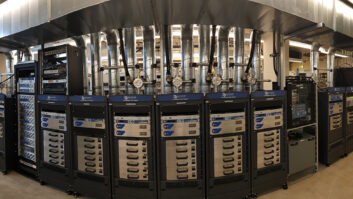You may remember last year’s photo of all the gate locks, looped through each other, to give everyone with a key their own point of entry. Yes, it works; but when some yahoo locks someone out by inadvertently forgetting to loop his lock through the right hasp, it’s time for the bolt cutters! (You do carry a pair in your trunk, right?)
Well, a Charlotte, N.C., company has come up with a better way. The system provides a logical and simple method of giving everyone access using their own lock.
Individual locks aren’t a bad idea. This approach helps solve the problems of trying to keeps keys straight among multiple users or of codes being lost or forgotten.
Reach Stymielock toll-free at (888) 278-9643 or visit www.stymielock.com.
Thanks to Ben Brinitzer, Clear Channel regional engineer, for sharing this great idea.
. . .
This is the time of year when storms will test your emergency systems. Here’s an add-on that could save your generator.
You’re probably heard of failures that occur when generators run out of fluids. The Model RAB Ren Oil Level Regulator maintains a constant oil level in the crankcase of your generator engine.
The device typically is mounted using two of the engine oil pan bolts, and is adjusted to the same height as the level of oil in the crankcase. Supply tanks are available in 5-, 15-, even 55-gallon sizes.
To round out your generator monitoring system, the Model L150 Swichgage Instrument, by Murphy, is a combination liquid level gauge and low limit switch.
The assembly includes a pivotal float connected to an indicating pointer and switching contact that closes when the level falls to the low-limit set point. The primary use of this gauge is for engine cooling systems; but it can also be used to monitor lube oil, hydraulic or diesel fuel reservoirs.
The switching contact can be used to activate an alarm or shut the system down at a pre-determined minimum level.
Mark Manuelian of Boston’s WBZ(AM) shared this information, which he received from engineer Warren Shulz at WLS(AM) in Chicago.
Warren is one of the station representatives for the Primary Entry Point Advisory Committee. Mark writes that when it comes to well-maintained emergency equipment, Warren is the expert.
Contact your local generator service company for more information.
. . .
Looking to harden your transmitter site? Mike McCarthy of McCarthy Radio Engineering, also in Chicago, has some tips.
Make sure the site has an agricultural/industrial first-aid kit.
A fire extinguisher is just as important. Use the type directed by your local fire code.
Check your supply of spare light bulbs — not only for the overhead fixtures and trouble lights, but also for transmitter pushbuttons and fault lighting.
Each site should have a basic tool kit of screwdrivers, nutdrivers, hex wrenches, a DVM, soldering iron/solder/sucker, as well as device-specific tools. A device-specific tool might be a right-angled Phillips for removing bolts in a transmitter, or the gas wrench used to remove a regulator from a tank of nitrogen.
A set of basic tools at each site will reduce your fix-it time, should you you show up in a vehicle without your tools.
Mike also includes a set of safety glasses.
As a safety measure, je has installed bulletproof light fixtures over the door and around the building. If the general manager doesn’t like it, Mike makes his point by saying that he needs to see where he is going and see who is coming up to him. For less than $200 a fixture, you can feel safe as you enter and leave the building.
Mike will walk away from a client who won’t allow for basic personal security — a point all of us need to remember. No station is worth giving your life for.
Toilet paper, paper towels and moist wipes, all in resealing plastic bags, will get plenty of use. The re-sealable bags will keep dry what’s supposed to stay dry, and keep the moist wipes wet.
. . .
Have you looked at your transmitter and air conditioner filters lately? Systems mounted on the roof, or in ceilings, can be easily forgotten.
Write the date you installed the filter on the cardboard frame. This helps you budget the number of filters used, as well as determine when the filters need to be changed.
. . .
The earlier mention of toilet paper for your transmitter supply kit reminds me of a story that you could only find in radio.
We were called in to do contract work for an owner who, unbeknownst to us, had quite a reputation for not always paying his engineers.
The transmitter was down, and the problem appeared to be the tube. The owner flashed a quick smile and said, “I’ve got plenty of tubes.”
He opened a closet door and we could see at least four tube boxes, two of which looked pretty new. However, as he opened each box, we discovered that it was empty — except for a raw, nose-wrinkling smell that soon filled the transmitter room as the last box was opened.
Seems one of the previous engineers who hadn’t been paid had taken the spare tubes — and also had realized that the reinforced box with the rounded foam insert made an ideal portable toilet.
Submissions for this column are encouraged, and qualify for SBE recertification credit. Fax your submission to (703) 323-8044, or send e-mail to [email protected]












